These two graphs show two different situations when the economy is not in equilibrium. At equilibrium, the long-run aggregate supply curve intersects where the short-run aggregate supply and aggregate demand intersect.
At times, our economy is producing below full employment, as shown on the left. In this case, there are unemployed resources, and unemployment is a concern.
It is also possible for the economy to be producing beyond full employment in the short term, illustrated on the right. In this case, inflation can become a major concern.
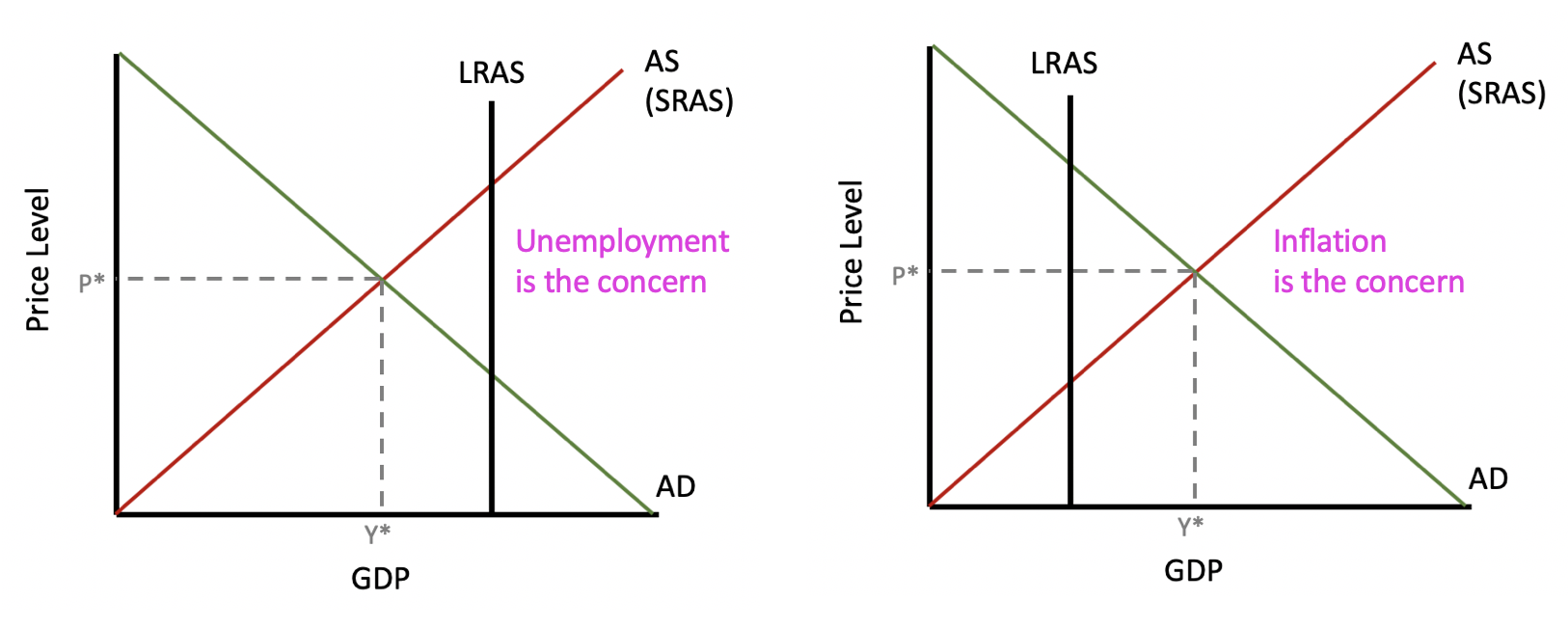
In either case, often intervention is needed, in the form of the government or the Federal Reserve.
When the government intervenes, it is called fiscal policy, which is policy typically set by a central government authority whereby government spending is adjusted to stabilize economic activity.
The government has two tools:
Monetary policy, on the other hand, is typically set by a central banking authority, whereby the money supply access and the resulting cost or access to money, which is the interest rate, is varied to assist in stabilizing economic activity.
The three tools of monetary policy are:
Expansionary policy is either monetary or fiscal policy that is enacted to stimulate economic growth as measured by the GDP growth rate.
So, why do we want to enact expansionary policy? Well, we do this when unemployment is the concern, or when we are producing below full employment.
Here is a chart outlining the tools used by both types of policy to expand the economy.
| Expansionary Policy | |
|---|---|
|
Monetary: Increase the money supply/Entice banks to make loans |
Fiscal: Encourage job creation and more spending in the economy |
|
1. Lower the RRR 2. Lower interest rates 3. Buy securities |
1. Increase government spending 2. Cut taxes |
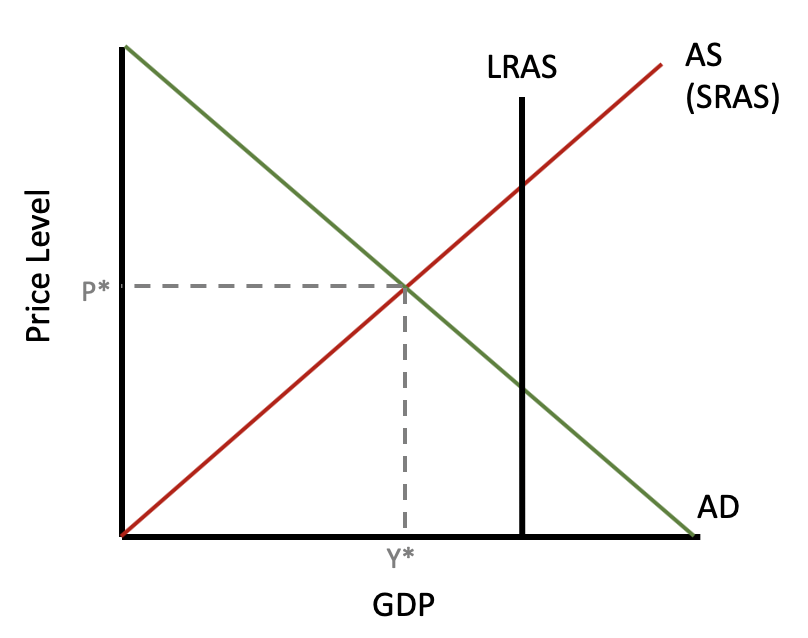
Fiscal policy, as mentioned, directly attempts to create demand by spending money to develop programs, jobs, etc.
Monetary policy works by increasing the money supply, encouraging people to spend money and take out loans.
Either way, the end result is an increase in aggregate demand, as you can see below, taking the economy to full employment, reducing the unemployment rate and utilizing all of the resources.
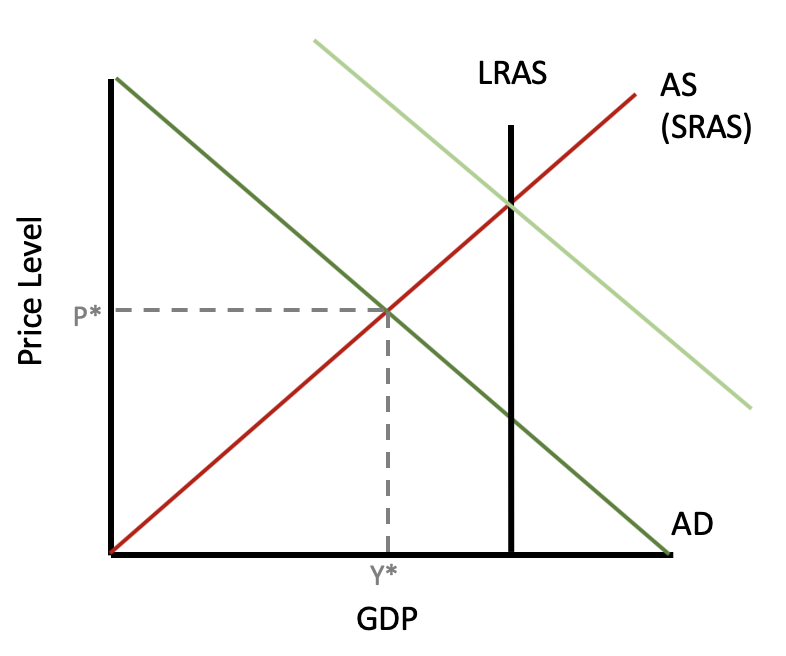
The money multiplier is equal to the ratio of the reserve requirement, which is 1 divided by R, where R is the reserve requirement, such that a given reserve requirement will result in a net multiple of the original increase, where we have to multiply by the change in loanable funds.

So, if a bank can even make one more loan as the result of a policy, this will create more and more loans possible.
With fiscal policy, if even one more person receives a paycheck as a result of a new government program, that person will spend money in businesses. This impacts other people, who then go out and spend more money, and so forth.
You can imagine how much more multiplied this becomes on a larger scale in the overall economy whenever expansionary policy is implemented.
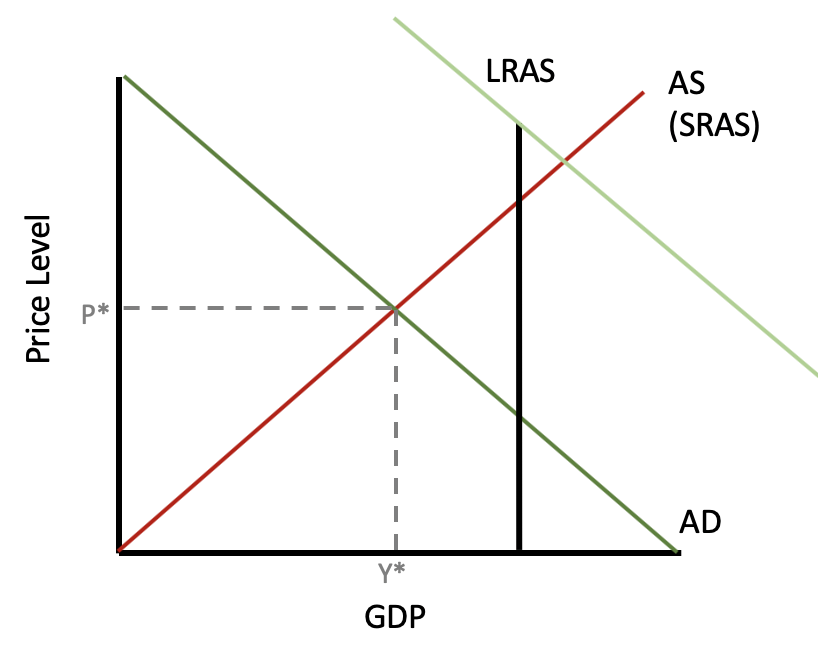
When that happens, notice how prices go up--and when prices go up, this includes input prices.
When suppliers or producers are experiencing increased prices, SRAS, or short-run aggregate supply, can shift to the left, bringing the economy back to equilibrium, but now at higher prices.
The end result would be an increase in prices or inflation.
Overstimulating aggregate demand is not ideal, because it is too difficult to get past the long-run aggregate supply curve and achieve long-run economic growth through solely stimulating aggregate demand.
Now let's look at the opposite situation when inflation is the concern. In this case, the government or the Fed needs to slow down the economy through contractionary policy, which is either monetary or fiscal policy that is enacted to slow economic growth, as measured by the GDP growth rate.
| Contractionary Policy | |
|---|---|
|
Monetary: Decrease the money supply/Entice people to keep money in banks |
Fiscal: Encourage less spending in the economy |
|
1. Raise the RRR 2. Raise interest rates 3. Sell securities |
1. Decrease government spending 2. Raise taxes |
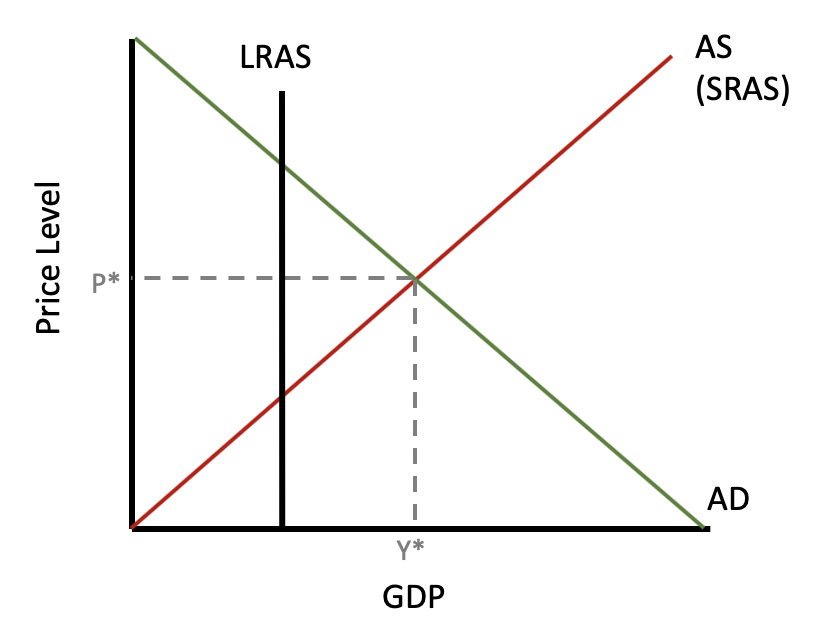
Fiscal policy decreases demand by cutting spending, while monetary policy works by decreasing the money supply, again encouraging people to save money and take out fewer loans.
Either way, the end result is a decrease in aggregate demand.
As you have seen on these graphs, theoretically there is a direct relationship between real GDP growth and the price level.
As aggregate demand is stimulated and increases, the economy grows and unemployment falls, pushing prices up.
As aggregate demand decreases, the economy contracts. By decreasing aggregate demand, the attempt is to push prices down. The trade-off is increased unemployment.
This is what the Phillips Curve illustrates. It is a graphical depiction of this inverse relationship between inflation and unemployment. Intuitively, higher employment or lower unemployment is consistent with a strong economy and demand. As demand increases beyond short-run supply capabilities or resource constraints, inflation begins to increase.

You can see the axes are annual inflation rate and unemployment rate. There is a trade-off between the two because they are inversely related.
When unemployment is low, we tend to have high inflation because of high demand. When unemployment rises, we have lower inflation.
If unemployment exceeds 10%, the government or Fed could enact expansionary policy. You can see that at a 10% unemployment rate, inflation is quite low.
Since inflation is not the concern, they could enact some type of expansionary policy, which will lower unemployment. However, there will be a slight increase in prices or inflation.
Now, if inflation exceeds 10%, which is extremely high, the government or the Fed could enact contractionary policy, since employment is significantly below full employment.
There could be lower inflation, but the trade-off is a slightly higher unemployment rate as demand in the economy starts to fall.
Very low levels of unemployment, less than 5%, are generally unsustainable and can create bubbles, such as the housing bubble in the early 2000s. In this case, the government or the Fed would want to cool down the economy in that case by enacting contractionary policies to prevent this from happening.
We would not be able to explain this with the simplified model above, because there were times in the 1970s when inflation was well over 10% coupled with an unemployment rate over 8%.
This would place us on a point well outside of the curve. We cannot simply move along this simplified Phillips curve and find that combination of unemployment and inflation.
Therefore, we would actually need to suggest that this Phillips curve could move over time, resulting in a much higher Phillips curve on this example graph.

Stagflation, then, is defined as the situation where both unemployment and inflation are high, contrary to the Phillips Curve. It occurs when policy actions fail to boost economic growth and the economy instead becomes stuck in this seeming impassible position.
Source: this work is adapted from sophia author kate eskra.